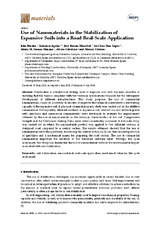Use of Nanomaterials in the Stabilization of Expansive Soils into a Road Real-Scale Application
Autor
Rosales García, Julia
Agrela Sáinz, Francisco
Marcobal, José Ramón
Díaz-López, José Luis
Cuenca Moyano, Gloria M.
Caballero, Álvaro
Cabrera, Manuel
Editor
MDPIFecha
2020Materia
Soil stabilizationNanomaterial
Real-scale application
Mechanical behavior
Life cycle assessment
METS:
Mostrar el registro METSPREMIS:
Mostrar el registro PREMISMetadatos
Mostrar el registro completo del ítemResumen
Stabilization is a traditional strategy used to improve soils with the main objective of ensuring that this base is compliant with the technical specifications required for the subsequent development of different infrastructures. This study proposes the use of commercial nanomaterials, based on a solution of silicates, to improve the technical characteristics and bearing capacity of the expansive soil. A physical–chemical property study was carried out on the additive nanomaterial. Subsequently, different mixtures of expansive soil, selected soil and artificial gravel with quicklime and commercial nanomaterials were developed to evaluate the improvement obtained by the use of nanomaterials in the technical characteristics of the soil. Compressive strength and the Californian Bearing Ratio index were considerably increased. A full-scale study was carried out in which the nanomaterial product was applied to two different sections of stabilized road compared to a control section. The results obtained showed that the use of nanomaterial led to the possibility of reducing the control section by 30 cm, thus achieving less use of quicklime and a mechanical means for preparing the road section. The use of commercial nanomaterial improved the behavior of the stabilized sub-base layer. Through life cycle assessment, this study has shown that the use of nanomaterials reduces the environmental impact associated with soil stabilization.

